Love mangoes? Then you have to try this classic Indian sweet mango pulp - Aamras!
Smooth, creamy, and bursting with tropical flavor, aamras is a beloved summer staple in many Indian homes. Naturally vegan and gluten-free, it's traditionally served with hot puris or sipped chilled as a dessert drink. Truly, it's sunshine in a bowl! Whether you're making it for festive meals, summer brunches, or simply because it's mango season, this easy aamras recipe is pure tropical indulgence.
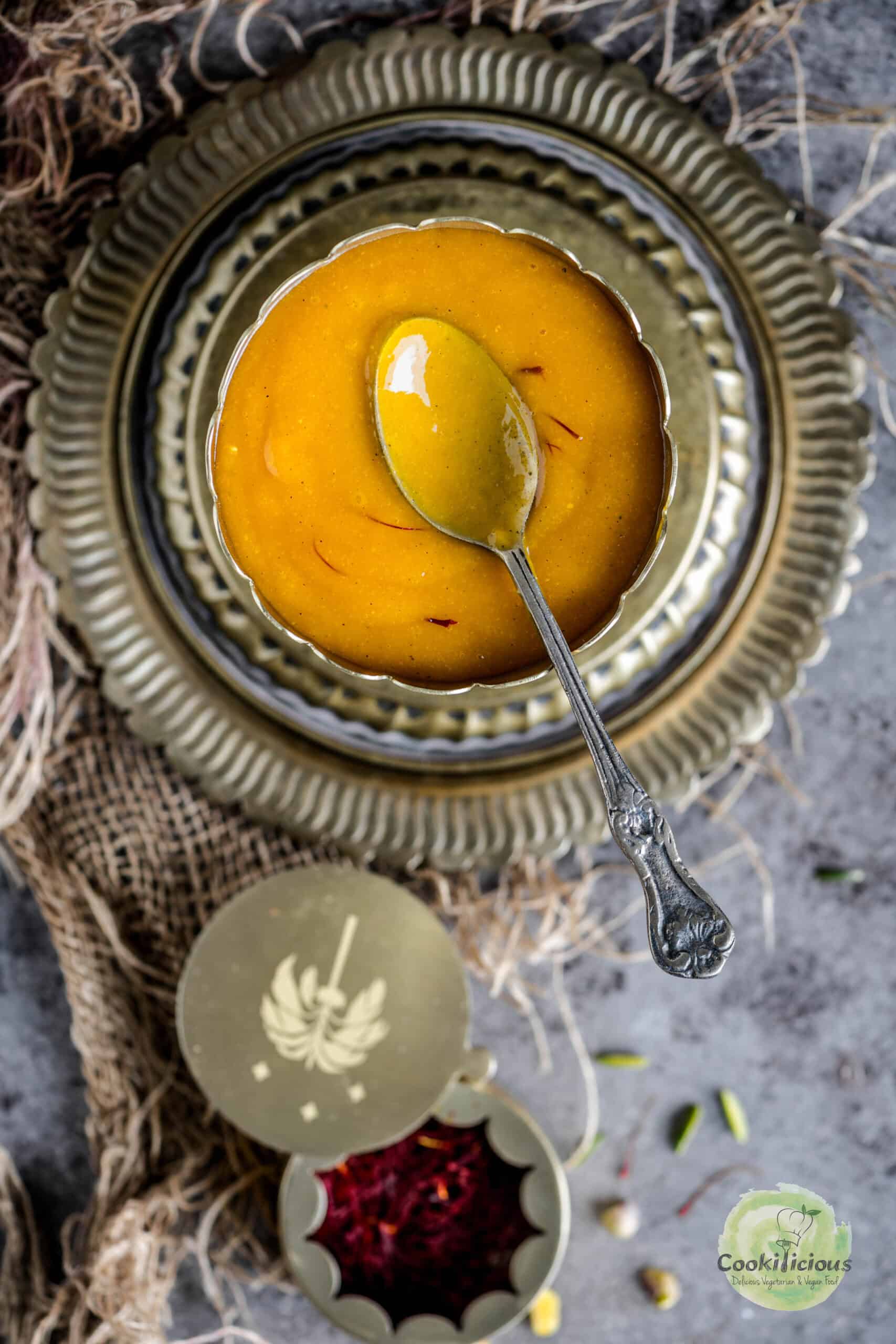
Jump to:
What is Aamras
Aamras is a classic Indian dessert made from ripe mango pulp. In Hindi, aam means mango and ras means juice or extract-so the literal meaning of aamras is mango juice. However, unlike mango juice which is usually thin and strained, aamras has a thick, velvety texture because it's made purely from mango pulp-often with minimal or no added liquid.
In Gujarati, this sweet mango pulp is called Keri no Ras (Keri meaning mango), and it's just as beloved. You can think of aamras as a rich, naturally sweet mango nectar that showcases the fruit in its most indulgent form.
Aamras is especially popular during the Indian summer when mangoes are in peak season. It's a staple dessert in many Indian households and is traditionally served with hot puris-a perfect blend of sweet and savory. This dish is particularly famous in the western states of Maharashtra, Gujarat, and Rajasthan, where it's often part of festive thalis and celebratory meals.
We Indians are passionate about mangoes-after all, mango is the national fruit of India! And aamras is one of the most iconic ways to enjoy this beloved fruit in its purest, most flavorful form. It's no surprise that aamras ranks among the top mango dishes in the world, celebrated for its simplicity, richness, and tropical sweetness.
How I Make Aamras At Home
I personally make aamras using fresh mango pulp without adding any milk, keeping the recipe simple, pure, and close to tradition. If you're looking for a mango pulp recipe that's easy, flavorful, naturally vegan, and packed with mango flavor-this one is for you!
In this post, you'll learn exactly how to make aamras at home, which mango varieties work best, the best way to store aamras, and some delicious flavor variations to elevate this classic summer favorite.
We love making recipes with mangoes in our home, especially when they're in season! If you're as mango-obsessed as we are, here are some delicious recipes you might want to try next: Mango Mastani, Mango Phirni, Mango Cranachan, Mango Rose Lassi, Mango Avocado Smoothie, Fajeto, and Mango Peach Popsicles.
Why Make It
- 🏡 Homemade aamras tastes much better than store-bought versions
- 🍯 Made with less sugar, no preservatives, and no artificial color-just pure mango goodness
- 🥭The taste is authentic and full of natural mango flavor
- ⏱️ Easy and quick to make-ready in just 15 minutes
- 🌱 Naturally vegan and 🌾 gluten-free
- 🧂 Made with only 5 simple ingredients
- ❄️ A no-cook dessert drink that's cool and refreshing
- 📦 Make ahead and store for later-perfect for meal prep or parties
Ingredients needed 🧾
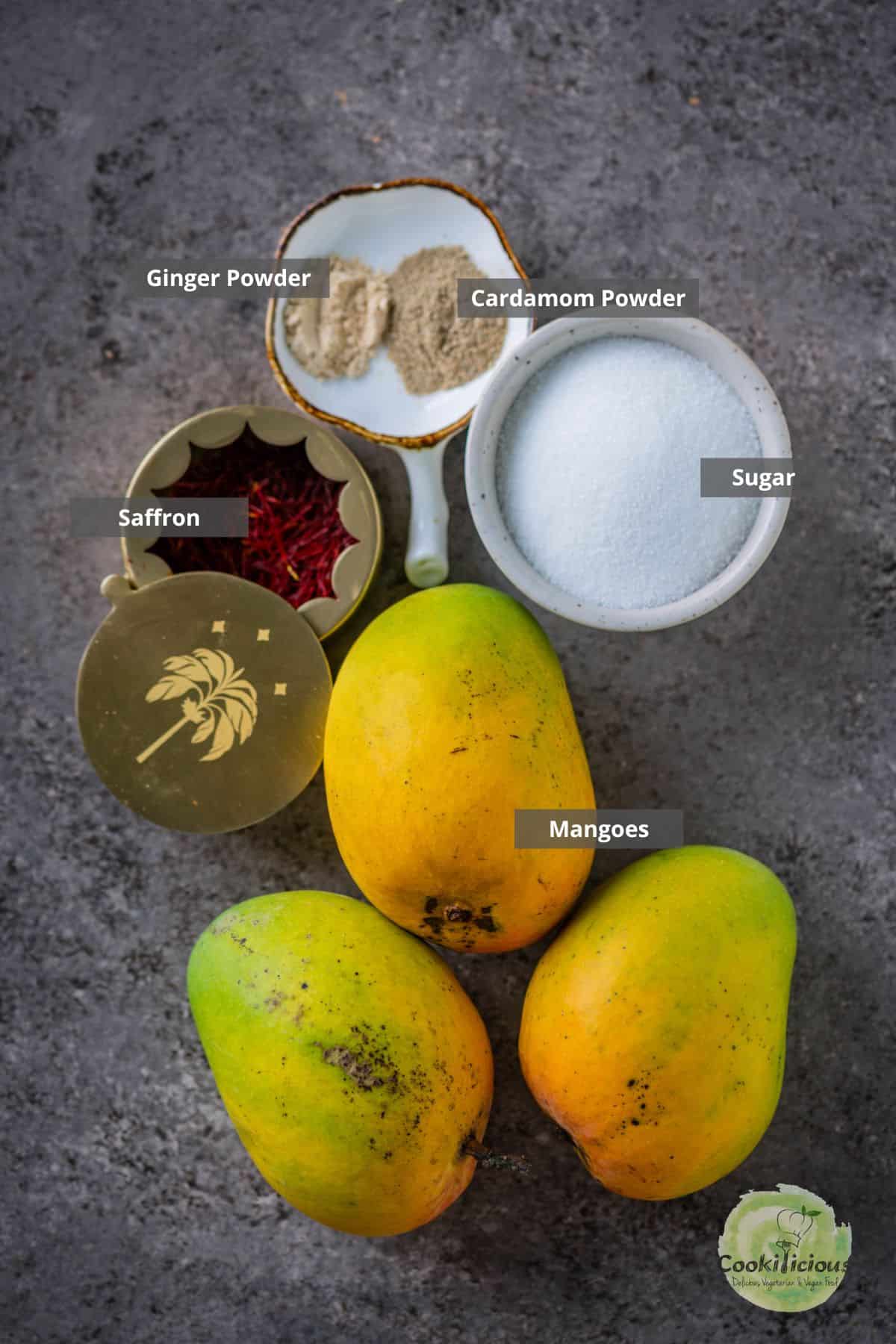
Mangoes are the heart of aamras, and since mango is a seasonal fruit in India, it's most commonly available during the summer months. To make the best aamras, choose ripe and juicy mangoes-Alphonso (Hapus) mangoes are the top choice for their sweetness, flavor, and rich color. Kesari mangoes are another excellent option. Make sure your mangoes aren't bruised, overripe, or dented, as they can affect the flavor and texture of the pulp.
If you end up with green, raw mangoes, don't waste them! Use them to make Indian Mango Pickle, or finely chop and add them as a tangy garnish to dishes like Sundal, or Bhel-they bring the perfect sour contrast.
To flavor your aamras, traditional Indian spices like cardamom powder, dry ginger powder, and a few strands of saffron work beautifully. Cardamom and ginger not only enhance the aroma and flavor but also aid in digestion, making aamras a delicious yet balanced treat.
For sweetness, regular fine white sugar works well, but feel free to use jaggery powder, vegan honey, maple syrup, or any sweetener of your choice. If your mangoes are naturally very sweet (especially Alphonso), you can even skip the sweetener altogether.
You can also optionally garnish your aamras with slivered almonds or pistachios to add a festive touch and a bit of crunch. While it's not necessary, it does elevate the dish-especially if you're serving it as part of a special meal or thali.
How to make it 🔪
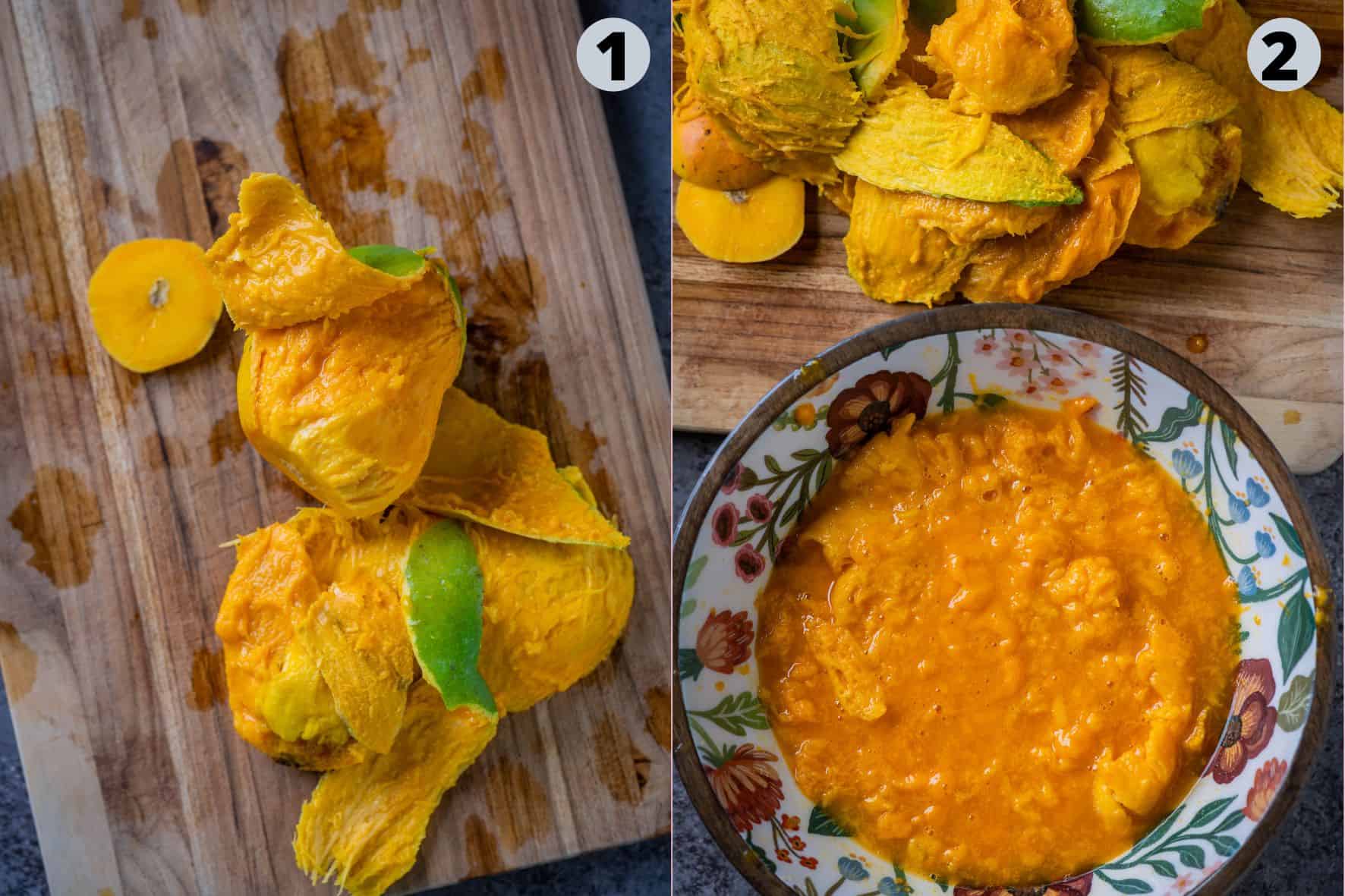
- Prep the mangoes: According to Ayurveda, mangoes generate internal heat, so it's best to soak them in water for a couple of hours before consuming-especially in hot and humid climates. Then wash them thoroughly, trim the tops, and peel off the skin. 👩🏽🍳 Chef tip: After soaking and washing, place the mangoes in the fridge to chill. This way, your aamras will already be cold, and consume it immediately instead of refrigerating it.
- Extract the pulp: Squeeze the mangoes by hand to get as much pulp and juice as possible-it might get messy, so gloves can help! Alternatively, you can cut them into small cubes. 👩🏽🍳 Chef tip: Don't discard the skin and seed. You can use them to make Mango Kadhi, add to dals, or rinse them with water and pour the remaining pulp into your bowl. 🍽️ Pro tip: You can puree the pulp and freeze it at this stage for up to 6 months-perfect for enjoying aamras year-round.

Want to save this recipe?
- Blend it smooth: Transfer the fresh mango pulp to a blender.
- Taste the pulp-then add sugar as needed.
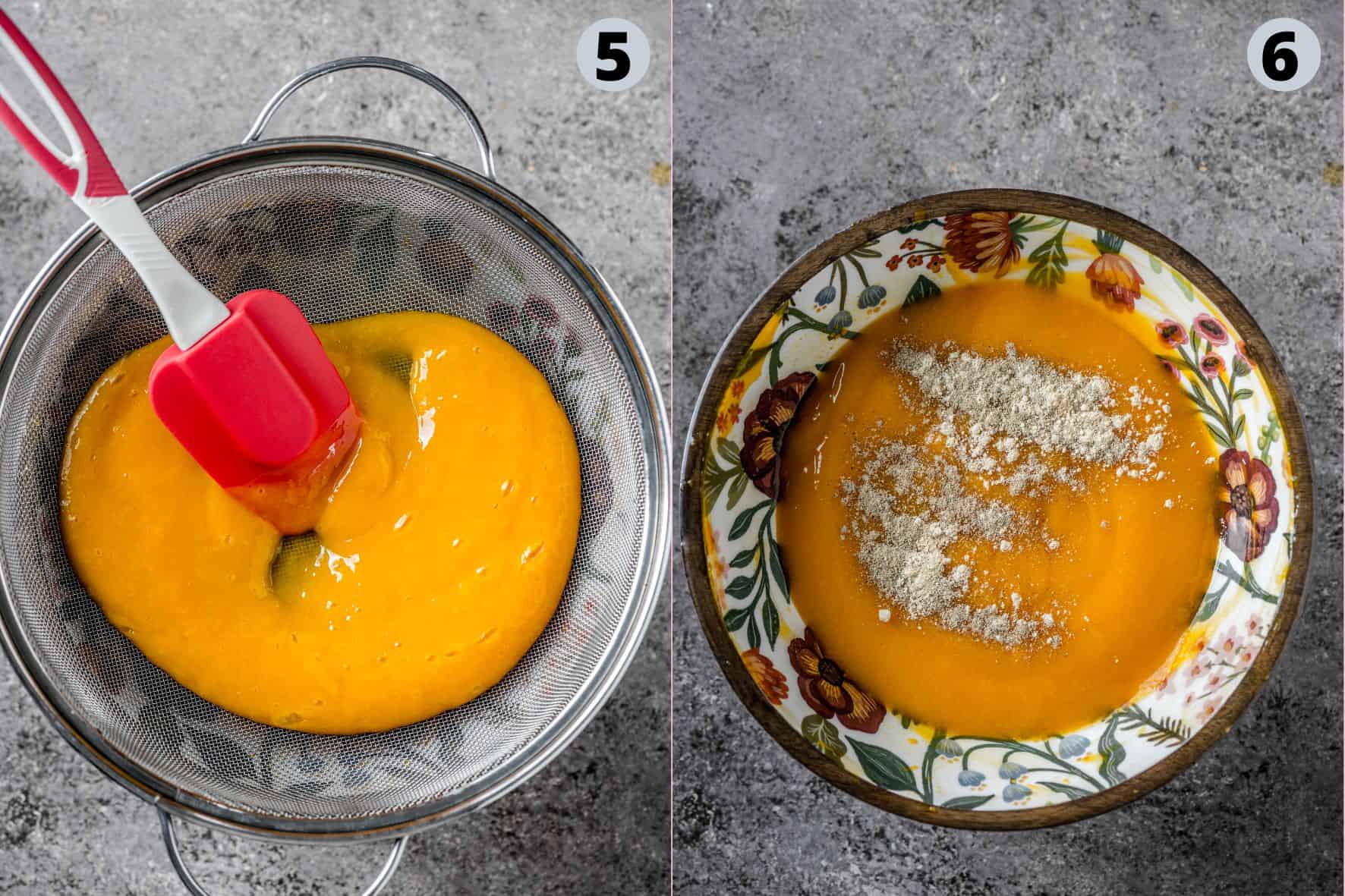
- Blend into a smooth puree. You can add a splash of water, ice cubes, or plant-based milk only if needed, but the consistency should resemble thick batter. Strain for smoothness (optional): Pass the aamras through a fine mesh strainer using a spoon or clean hands to gently press it through. This step is optional, but it gives you an ultra-smooth, silky, and luscious mango pulp minus the fiber.
- Add ground ginger, cardamom powder, and a pinch of salt to balance the sweetness and enhance digestion. Taste again and adjust sweetness if needed. Whisk well to combine, garnish with saffron strands, and serve your chilled aamras right away.
👩🏽🍳 Chef tip: If you haven't pre-chilled your mangoes, refrigerate the aamras for at least 30 minutes before serving.
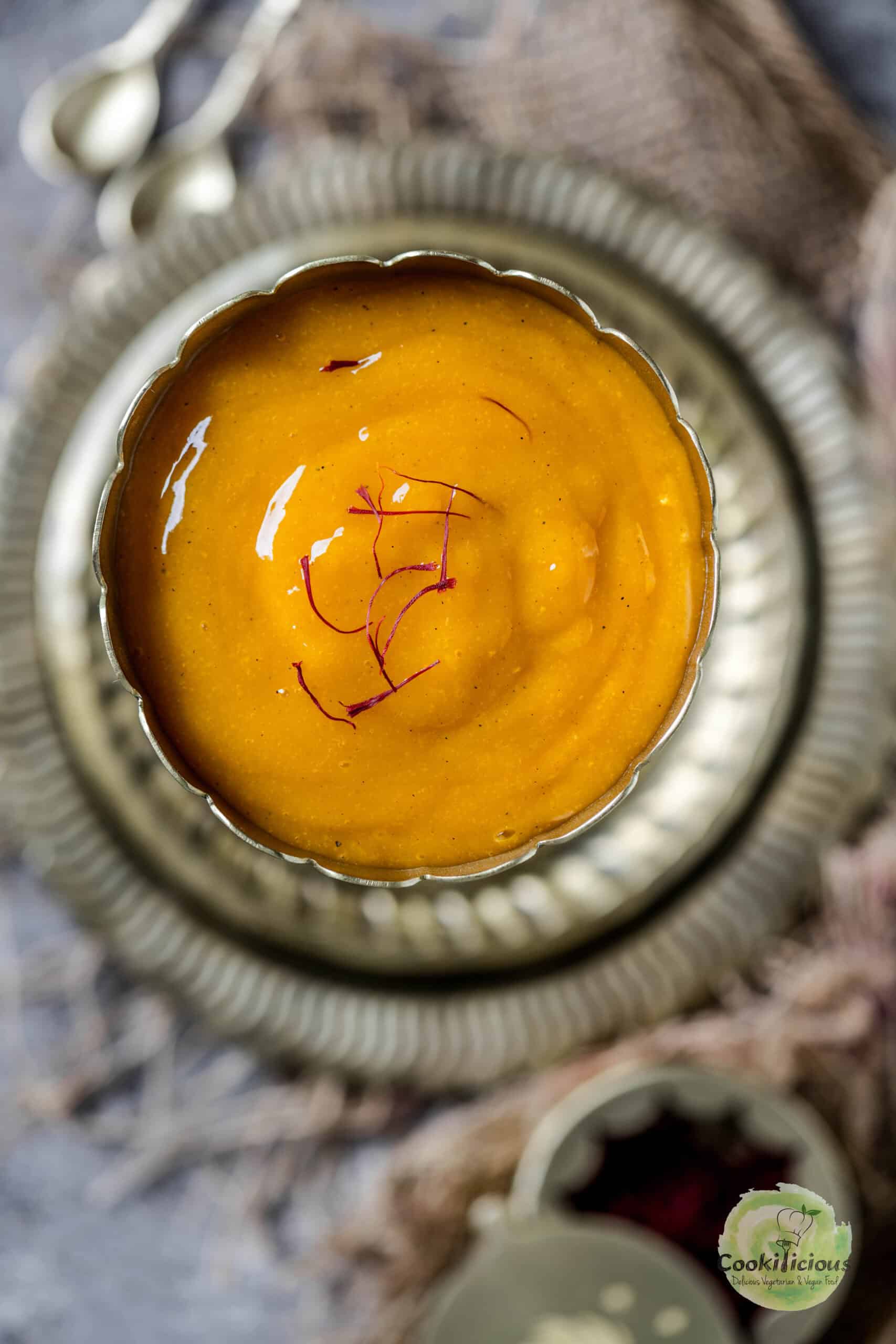
Serving suggestions 🍽
Always serve aamras chilled to enjoy its refreshing, vibrant flavors. Before serving, garnish it with a mix of chopped nuts like almonds and pistachios along with a few strands of saffron for a beautiful and aromatic finish. For a richer, traditional touch, drizzle some regular ghee or vegan ghee on top.
You can serve aamras in individual bowls, or for a more elegant presentation, try shot glasses, martini glasses, or dessert jars-perfect for parties and special occasions. This creamy mango ras makes an ideal dessert for summer brunches, backyard gatherings, potlucks, family get-togethers, date nights, game nights, and festive celebrations such as Raksha Bandhan, Diwali, Holi, as well as global holidays like Thanksgiving and Christmas.
What to serve with Aamras
Aamras tastes best when paired with hot, crispy puris and a side of flavorful Potato Fry, making Aamras and Puri a beloved dish often served at summer weddings and special occasions across India. Beyond puris, Mango Rus also pairs wonderfully with roti, neer dosa, rice, or the sweet, stuffed Indian bread called Puran Poli.
Adding a bowl of aamras to a traditional Indian thali elevates the meal with its sweet, refreshing contrast. Some people enjoy unique combinations like Bhindi Masala and aamras or the classic South Indian favorite, Curd Rice with aamras.
Personally, I love having a bowl of aamras as a sweet dish after any meal or simply as a refreshing snack. For kids, a scoop of vanilla ice cream alongside aamras makes for an irresistible treat. Whether served traditionally or with a modern twist, aamras is a must-try dessert that mango lovers will adore.
Top recipe tips 💭
Adjust the sugar in your aamras based on the mango's natural sweetness, but remember that too much sugar can thin the pulp. Traditional aamras should be thick and creamy, so add a little water, dairy milk, or plant-based milk or cream only if needed to adjust the consistency. Straining the mango puree is optional, but recommended if you want a smooth, fiber-free texture-especially when using fibrous mango varieties.
FAQs 📖
This mango pulp recipe is best made with ripe and juicy Indian Alphonso (Hapus) and Kesar mangoes are hands down the best choices. These varieties are prized for their rich flavor, creamy texture, and natural sweetness, making them ideal for this classic Indian dessert. Other popular varieties like Payari, Langra, Dusheri, Raspuri, Badami, and Banganapalli also work wonderfully and are commonly found in Indian grocery stores or online from trusted sellers.
While Mexican varieties like Ataulfo mangoes are less sweet, they can be used if fresh Indian mangoes are unavailable. The sweeter the mango, the better your aamras will taste-you can often judge sweetness by the strong, fragrant aroma of the fruit.
If you're using frozen mangoes, simply thaw them slightly before blending. Avoid store-bought sweetened or canned mango pulp as they tend to have excess sugar and preservatives, but unsweetened mango pulp is a good convenient alternative.
If you don't have a blender, you can still make delicious mango ras using simple and traditional hand techniques. Depending on the mango variety, start by rolling the mango gently on a surface to loosen the pulp from the skin.
Then, peel the mango and cut or pinch off the top to squeeze out the juice. Massage or squish the mango with your hands to extract more pulp and make it slightly more liquid. You can also mash the pulp with a spoon or fork to break it down further.
For a smoother texture, pass the mashed pulp through a fine sieve, but keep in mind that without a blender, the consistency won't be as silky and luscious. Despite this, the taste of your homemade aamras will still be wonderfully fresh and authentic.
Leftover Keri no Ras (aamras) is a versatile ingredient that can be transformed into many delicious treats. You can turn it into refreshing ice cream or popsicles (kulfi)-for inspiration, check out recipes like my Carrot Halwa Ice Cream or Guava Ice Cream. Feeling adventurous? Try making a trendy Dalgona Mango by mixing aamras with whipped coffee foam, inspired by the popular Dalgona Coffee recipe.
For a creamy twist, combine aamras with Greek yogurt to make a luscious Mango Shrikhand. Classic options like Mango Shake or Mango Lassi are always crowd-pleasers. You can also use aamras as a base for a nutritious smoothie bowl topped with chopped mangoes, nuts, and seeds. For a comforting dessert, stir it into kheer to create flavorful Mango Kheer. These ideas ensure none of your precious aam ras goes to waste!
Aamras is wonderfully versatile, and many households add their own unique flavor twists to this classic mango pulp dessert. Some like to enhance the flavor with warm spices such as ground cloves, nutmeg, fennel powder, or even a subtle hint of black pepper.
Adding a drizzle of ghee lends a rich, aromatic touch that elevates the experience. For a refreshing citrus twist, mixing in a splash of orange juice adds brightness and complexity. In Gujarat, when aamras is blended with yogurt, it becomes Matho, a tangy and creamy variation.
You can enjoy aamras dessert either with these spice infusions or keep it simple and pure-just ripe mango pulp and sugar-for a clean, natural mango flavor that lets the fruit shine.
Mango Ras can be stored easily at home for up to 5-6 days in the refrigerator. Over time, you may notice slight discoloration, which is natural due to the fruit oxidizing when exposed to air. To maintain its vibrant color and freshness, store aamras in an airtight container and minimize air exposure. For longer storage, aam ras can be frozen for up to 6 months without losing much of its delicious flavor, making it a great option to enjoy this seasonal treat year-round.
Adding ice cubes while grinding mangoes can help keep the pulp cool and slightly thicker, which may slow down discoloration to some extent. However, the main cause of browning is enzymatic oxidation when the mango pulp is exposed to air. To better prevent this, work quickly, store the puree airtight, and add a little lemon or lime juice to preserve its vibrant color. Keeping the puree refrigerated or freezing it also helps maintain freshness and color.
More Dessert Recipes
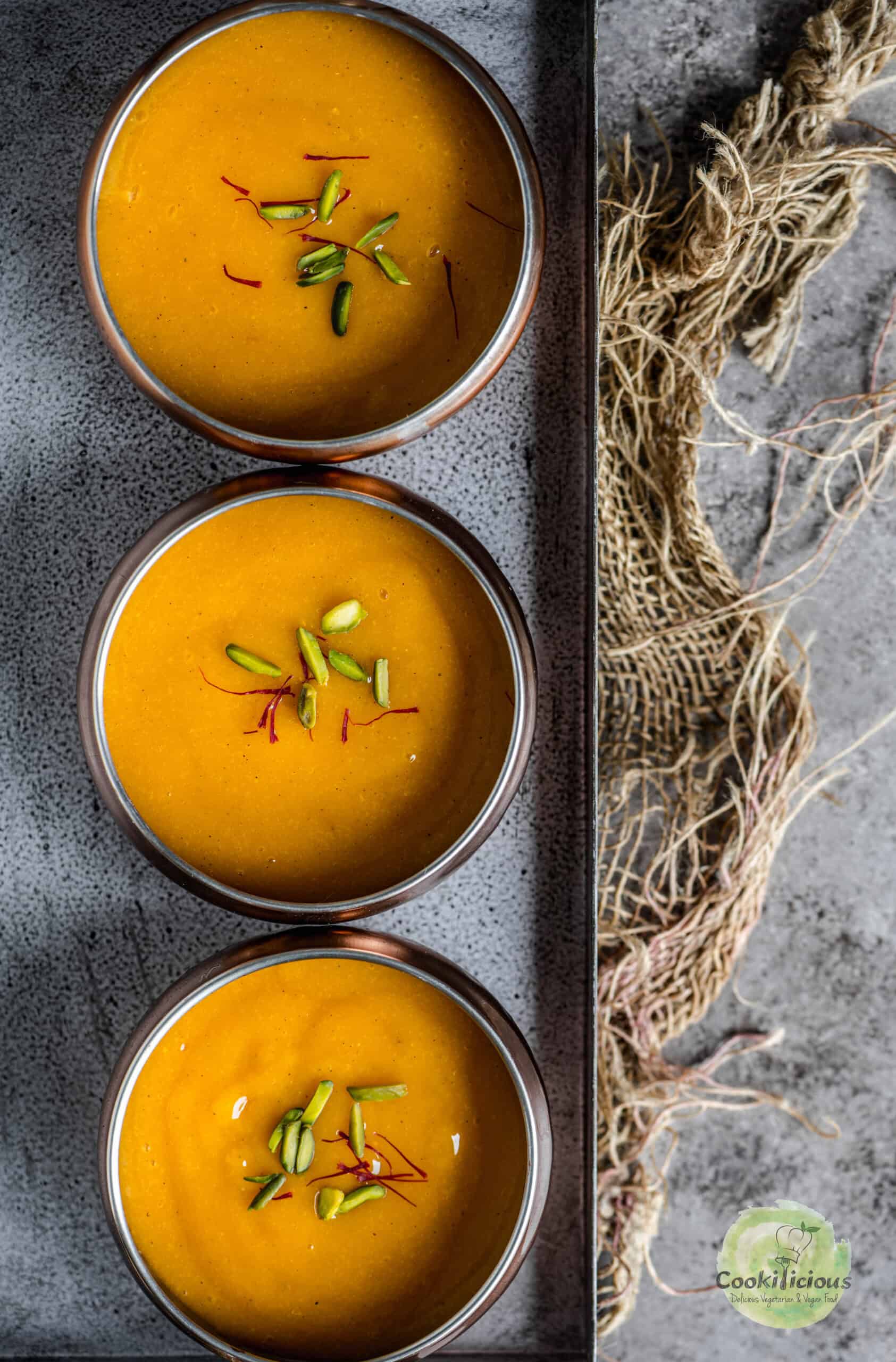
⭐️ Subscribe to the Cookilicious Newsletter and receive new recipes straight to your inbox! You'll receive my FREE Vegan Beginner's guide as a gift. Ready to elevate your cooking game? Purchase my Cookbook - The Essential Vegan Indian Cookbook today!
Recipe 📖
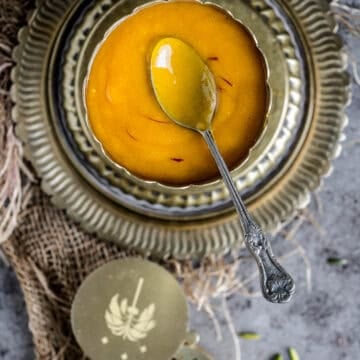
Easy Aamras Recipe - How to Make Sweet Mango Pulp
Equipment
Ingredients
- 900 gms Alphonso mangoes (or 4 mangoes) or Kesar mangoes
- ¼ cup fine sugar
- ¼ teaspoon cardamom powder
- ¼ teaspoon ginger powder
- ½ teaspoon saffron
- pinch salt
- 1 tablespoon mixed chopped nuts optional
Instructions
- Prep the mangoes: According to Ayurveda, mangoes generate internal heat, so it's best to soak them in water for a couple of hours before consuming-especially in hot and humid climates. Then wash them thoroughly, trim the tops, and peel off the skin. 👩🏽🍳 Chef tip: After soaking and washing, place the mangoes in the fridge to chill. This way, your aamras will already be cold, and consume it immediately instead of refrigerating it.
- Extract the pulp: Squeeze the mangoes by hand to get as much pulp and juice as possible-it might get messy, so gloves can help! Alternatively, you can cut them into small cubes. 👩🏽🍳 Chef tip: Don't discard the skin and seed. You can use them to make Mango Kadhi, add to dals, or rinse them with water and pour the remaining pulp into your bowl. 🍽️ Pro tip: You can puree the pulp and freeze it at this stage for up to 6 months-perfect for enjoying aamras year-round.
- Blend it smooth: Transfer the fresh mango pulp to a blender.
- Taste the pulp-then add sugar as needed.
- Blend into a smooth puree. You can add a splash of water, ice cubes, or plant-based milk only if needed, but the consistency should resemble thick batter. Strain for smoothness (optional): Pass the aamras through a fine mesh strainer using a spoon or clean hands to gently press it through. This step is optional, but it gives you an ultra-smooth, silky, and luscious mango pulp minus the fiber.
- Add ground ginger, cardamom powder, and a pinch of salt to balance the sweetness and enhance digestion. Taste again and adjust sweetness if needed. Whisk well to combine, garnish with saffron strands, and serve your chilled aamras right away. 👩🏽🍳 Chef tip: If you haven't pre-chilled your mangoes, refrigerate the aamras for at least 30 minutes before serving.

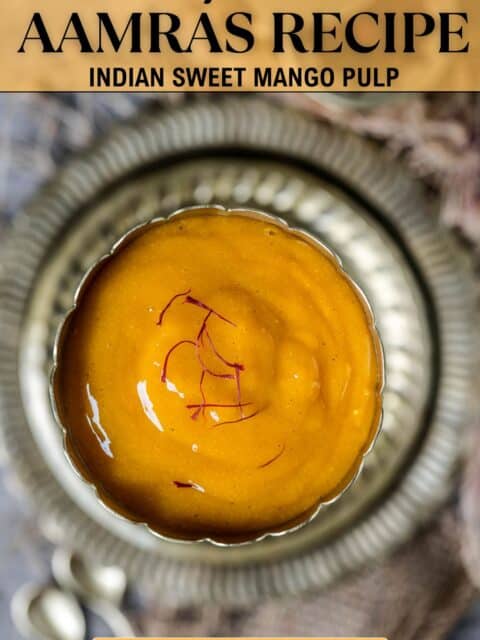
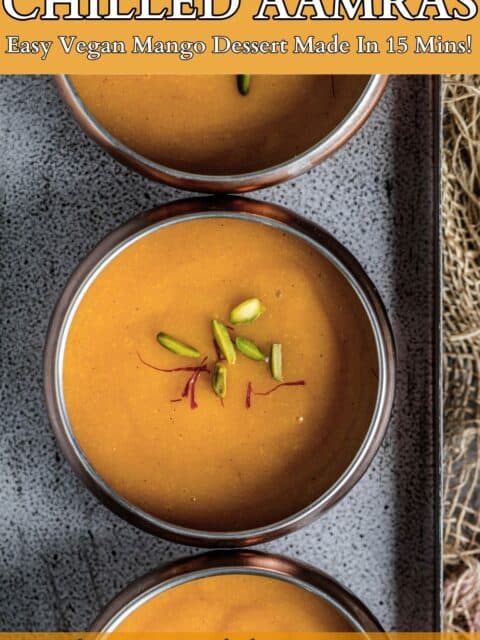
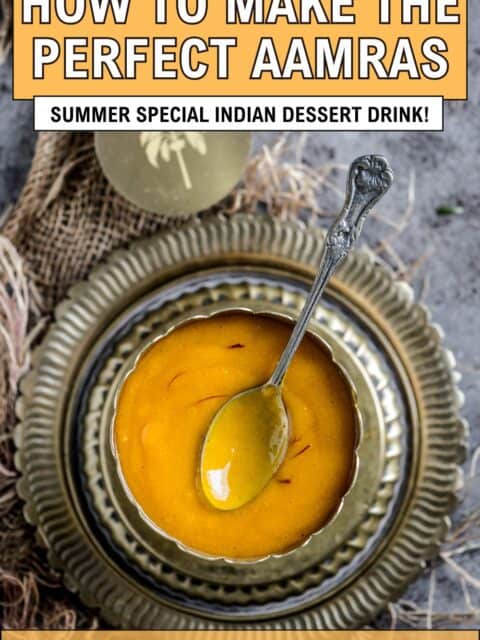
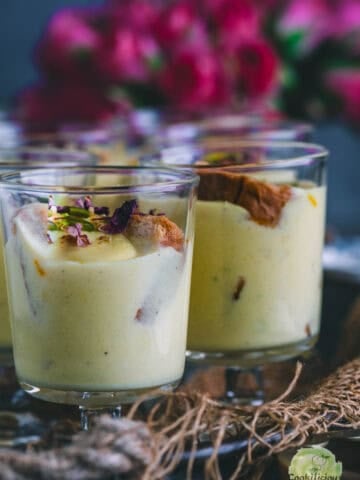
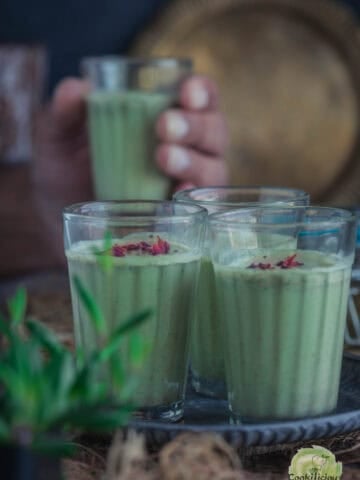

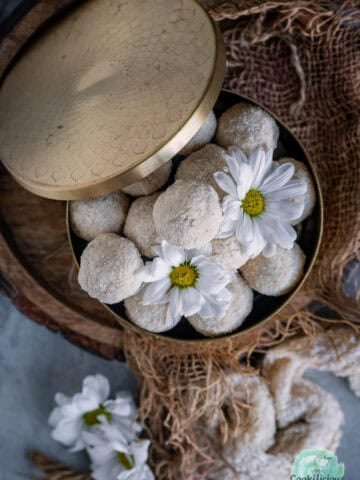
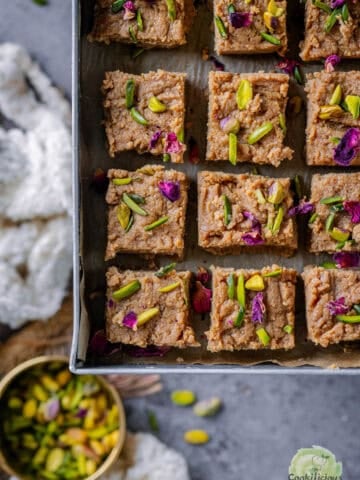
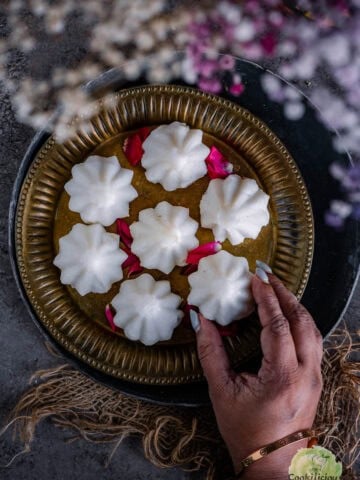
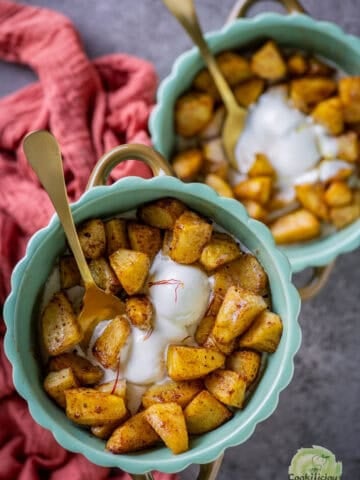
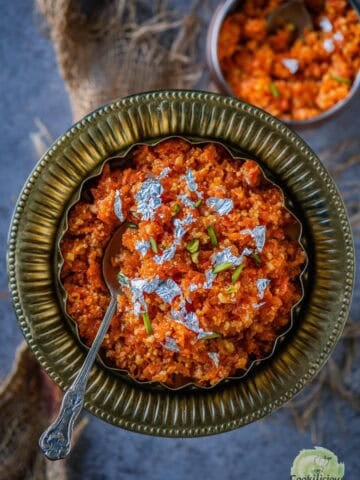
Leave a Reply